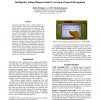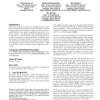90 search results - page 2 / 18 » Correcting Errors in Speech Recognition with Articulatory Dy... |
IROS
2008
IEEE
13 years 11 months ago
2008
IEEE
— This paper proposes a computational model for phoneme acquisition by infants. Human infants perceive speech sounds not as discrete phoneme sequences but as continuous acoustic ...
AAAI
2010
13 years 6 months ago
2010
Correcting recognition errors is often necessary in a speech interface. These errors not only reduce users' overall entry rate, but can also lead to frustration. While making...
AVI
2008
13 years 7 months ago
2008
This paper presents an interactive visualisation system that assists users of semi-automatic speech transcription systems to assess alternative recognition results in real time an...
SPEECH
2008
13 years 5 months ago
2008
In this paper, we describe a statistical approach to both an articulatory-to-acoustic mapping and an acoustic-to-articulatory inversion mapping without using phonetic information....
ICASSP
2009
IEEE
13 years 3 months ago
2009
IEEE
In an attempt to overcome problems associated with articulatory limitations and generative models, this work considers the use of phonological features in discriminative models fo...


